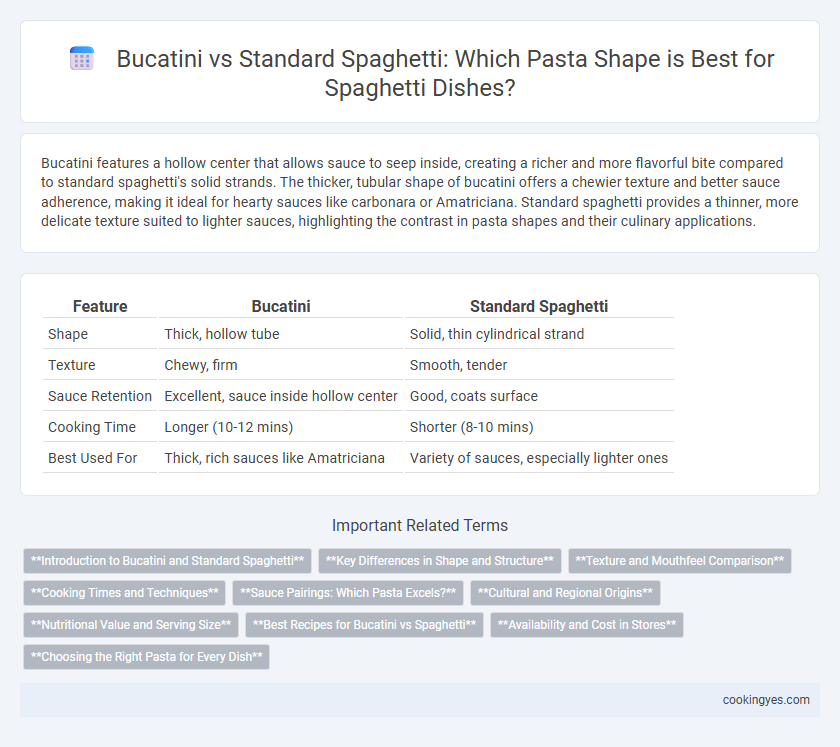Bucatini features a hollow center that allows sauce to seep inside, creating a richer and more flavorful bite compared to standard spaghetti's solid strands. The thicker, tubular shape of bucatini offers a chewier texture and better sauce adherence, making it ideal for hearty sauces like carbonara or Amatriciana. Standard spaghetti provides a thinner, more delicate texture suited to lighter sauces, highlighting the contrast in pasta shapes and their culinary applications.
Table of Comparison
| Feature | Bucatini | Standard Spaghetti |
|---|---|---|
| Shape | Thick, hollow tube | Solid, thin cylindrical strand |
| Texture | Chewy, firm | Smooth, tender |
| Sauce Retention | Excellent, sauce inside hollow center | Good, coats surface |
| Cooking Time | Longer (10-12 mins) | Shorter (8-10 mins) |
| Best Used For | Thick, rich sauces like Amatriciana | Variety of sauces, especially lighter ones |
Introduction to Bucatini and Standard Spaghetti
Bucatini is a thick, hollow pasta resembling a spaghetti strand with a central hole, creating a unique texture that holds sauces more effectively. Standard spaghetti is a solid, cylindrical pasta known for its versatility and smooth surface, ideal for a wide range of sauces and preparations. The hollow structure of bucatini offers a chewier bite compared to the firm yet tender texture of standard spaghetti, enhancing the overall pasta experience.
Key Differences in Shape and Structure
Bucatini differs from standard spaghetti primarily in its hollow center, creating a tube-like structure that allows it to hold sauces inside, enhancing flavor absorption. Standard spaghetti is solid and cylindrical, offering a smooth and consistent texture that works well with a variety of sauces. The hollow shape of bucatini provides a chewier bite and increased surface area compared to the uniform solidity of traditional spaghetti.
Texture and Mouthfeel Comparison
Bucatini offers a unique texture with its hollow center, providing a firmer bite and a slightly chewy mouthfeel compared to standard spaghetti's smooth and uniform strand. The hollow core of bucatini allows it to hold sauces both inside and out, enhancing flavor delivery with each bite. Standard spaghetti provides a more delicate and consistent texture that complements lighter sauces without overwhelming the palate.
Cooking Times and Techniques
Bucatini requires a slightly longer cooking time than standard spaghetti, typically around 9 to 12 minutes compared to 7 to 10 minutes for spaghetti, due to its thicker, hollow structure. The hollow center of bucatini allows for even heat penetration, which benefits from gentle stirring to prevent sticking and ensure uniform cooking. Standard spaghetti cooks faster and can be boiled vigorously, making it ideal for quick recipes and lighter sauces.
Sauce Pairings: Which Pasta Excels?
Bucatini's hollow center allows it to trap thicker sauces like carbonara and amatriciana more effectively than standard spaghetti, enhancing every bite with rich flavor. Standard spaghetti pairs best with lighter sauces such as marinara and aglio e olio, where its smooth surface evenly coats the strands. Choosing between bucatini and standard spaghetti depends on the sauce's texture and intensity to maximize taste and mouthfeel.
Cultural and Regional Origins
Bucatini, a traditional pasta originating from the Lazio region of Italy, is characterized by its hollow center, which allows it to hold more sauce compared to standard spaghetti. Standard spaghetti, widely popular across Italy and globally, traces its roots to Southern Italy, often associated with simpler, thinner strands ideal for a variety of sauces. Both pasta shapes reflect their regional culinary practices, with bucatini commonly featured in Roman dishes like Amatriciana, while spaghetti is a versatile staple across diverse Italian regional cuisines.
Nutritional Value and Serving Size
Bucatini and standard spaghetti differ primarily in shape, with bucatini featuring a hollow center that holds more sauce, potentially affecting portion perception and calorie consumption. Nutritionally, both pasta types have similar macronutrient profiles per serving, typically providing around 200 calories, 7 grams of protein, and 1 gram of fat per 2-ounce dry portion. Serving size recommendations remain consistent, but bucatini's denser texture may lead to increased satiety, influencing overall intake and nutrient absorption.
Best Recipes for Bucatini vs Spaghetti
Bucatini's hollow center makes it ideal for rich, creamy sauces like carbonara or amatriciana, as the sauce clings inside and outside the pasta for intense flavor in every bite. Standard spaghetti pairs best with lighter tomato-based sauces, olive oil, garlic, or simple marinara, providing a smooth texture that complements fresh ingredients without overwhelming them. For dishes featuring meatballs or seafood, spaghetti maintains its classic appeal, while bucatini enhances recipes where sauce absorption and texture make a significant difference.
Availability and Cost in Stores
Bucatini is typically less available than standard spaghetti in most grocery stores, often found only in specialty or Italian markets. Standard spaghetti enjoys widespread availability and generally comes at a lower cost due to higher demand and mass production. Consumers seeking bucatini should expect to pay a premium price compared to standard spaghetti varieties.
Choosing the Right Pasta for Every Dish
Bucatini pasta, characterized by its hollow center, offers a unique texture that holds sauces exceptionally well, making it ideal for rich, hearty dishes like Amatriciana or carbonara. Standard spaghetti, with its solid, thin strands, is versatile and suits lighter sauces such as marinara or aglio e olio, allowing flavors to coat the surface evenly. Selecting the right pasta shape enhances the dining experience by balancing sauce adherence and bite texture, ensuring each dish's traditional flavor profile and consistency are preserved.
Bucatini vs standard spaghetti for pasta shape Infographic

 cookingyes.com
cookingyes.com